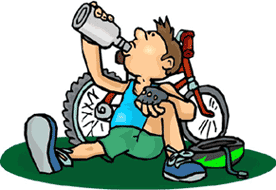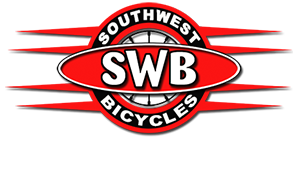Our Energy-Food Tips For Riding Stronger & Longer |  |
| 1. Your body can store roughly an hour-and-a-half to two-hours worth of glycogen (muscle fuel). So, if you're riding longer, you need to carry food (or stop to purchase it) and consume enough calories to keep from developing a glycogen deficit and running out of energy. | |
| 2. It's best to carry energy drinks (versus water) because they are easily consumed and provide fuel in the form of steady complex carbohydrates, as well as replenishing electrolytes and minerals lost through sweating. | |
| 3. Start drinking before you're thirsty because by the time your brain signals thirst, you've already lost one percent of your body weight in sweat! | |
| 4. You should carry an energy drink you enjoy because if it tastes good, you'll drink more. And, if it tastes bad, you won't drink enough, if at all. Be sure to taste test while riding because the drink may taste differently than it did at home. | |
5. Cold liquids are absorbed by your system more quickly. Keep your drinks cooler longer by inserting ice or by freezing half-full bottles the night before the ride and topping them off in the morning. You might also consider using insulated bottles. If you're using a hydration pack, adding ice will keep your torso cool, too. | |
| 6. When you're carrying energy drink in two bottles, lower the concentration in your second bottle because as you fatigue and heat up, you'll likely prefer less flavor and sweetness. | |
| 7. If you're riding hard, it's also important that your energy drink isn't too concentrated. Too rich a mixture can upset your stomach and even slow down or prevent absorption. | |
| 8. To make sure you're properly hydrated before an event, check your urine. It should be pale yellow or clear. Dark yellow and strong-smelling urine is a reminder to drink a few more glasses of liquid, although vitamin pills can have a coloring effect as well. Another key sign of proper hydration is having to get up during the night before the event to urinate. | |
9. Jersey pockets are designed to carry energy bars, fig bars, fruit and energy gels. Plus, it's easy to reach the food stored this way so you're more likely to eat it. | |
| 10. For competition, when it can be hard to retrieve food from a pocket, racers sometimes use electrical tape to stick packets of energy gel to their top tube or stem for easy access. | |
| 11. For high-intensity events or rides, energy gels and drinks work better than energy bars. They can be swallowed in seconds (chewing an energy bar can interfere with breathing) and the ingredients enter your system quickly. | |
| 12. Twenty miles into a century is no time to find out that the energy drink your training partner recommended upsets your stomach. So be sure to experiment in training or on rides that are not as important as your big event to make sure that your food and drink choices are right for you. | |
| 13. Energy drinks specifically formulated for pre-workout provide easily digested liquid calories designed to enhance endurance. Look for an all-purpose supplement that supplies healthy complex carbohydrates and protein with low sugar and fat. The carbos replenish your energy reserves, while protein helps your muscles recover and rebuild from the trauma of hard efforts. You may find that energy bars, fruit and cereal make good pre-workout meals, too. | |
| 14. Eat within one hour of your workout/event and you'll recover fastest. During this hour the muscles absorb the most nutrients and glycogen, an energy reserve in your muscles, is replaced most efficiently. | |
ON THE NEW RIVER BIKE TRAIL // Mon - Sat 9am - 6pm, Closed Sun
